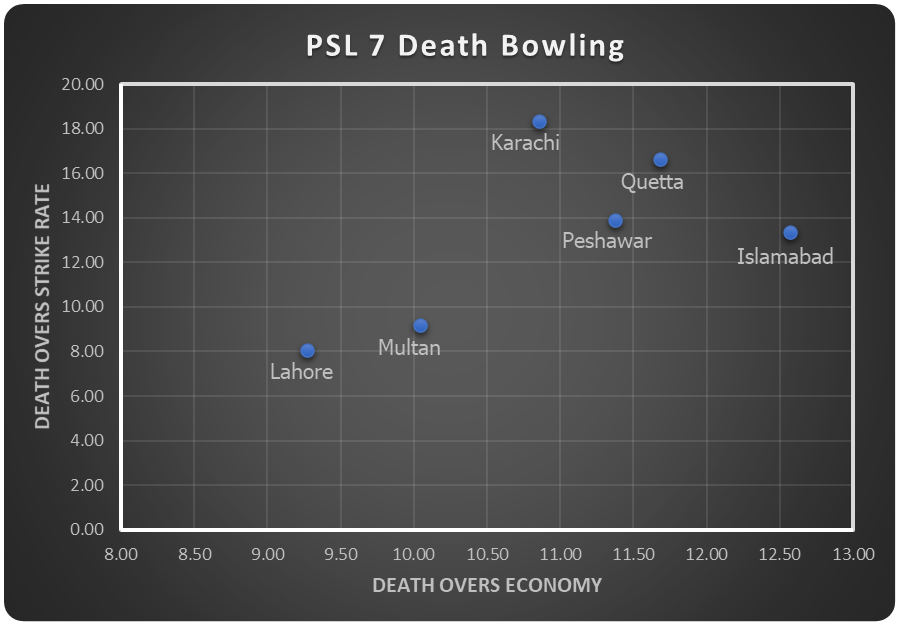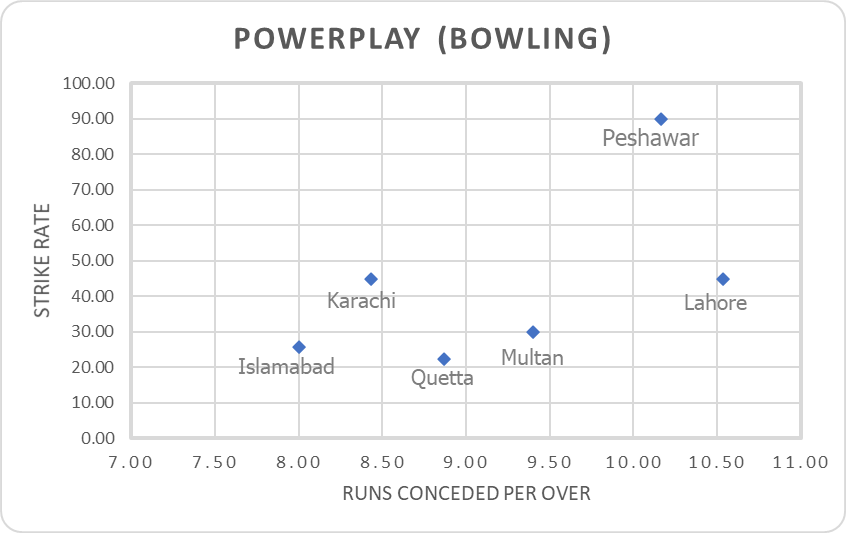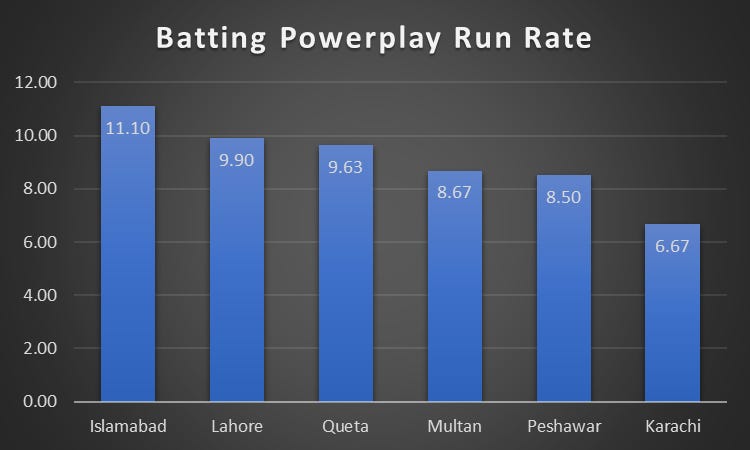PSL 7 by the numbers
An analytic approach to peeling the onion
We’re halfway through the group stage in PSL 7 as the teams get ready to begin the 2nd leg and subsequent knockouts in Lahore. As the teams rest, this gives the analytic minds a chance to evaluate how the season has gone, and, whilst acknowledging the small sample size, perhaps get a sense on how the remainder of the season will unfold. Let’s dive in and evaluate various aspects of the teams, shall we?
I’m of the belief that bowling wins championships, and batting sides can break the game open in the powerplay given the advantage they have in that phase of the game. So let’s begin by looking at how the various bowling units have fared.
We have a huge outlier in Peshawar who seem allergic to taking wickets in the powerplay and concede over 10 an over during the first phase of the match. On the other end of the spectrum, Islamabad is very close to that bottom left sweet spot. The most surprising reveal here is despite Lahore’s prestigious bowling attack, they’ve been quite mediocre to start the match. Shaheen has a history of taking a wicket in his first over around 33% of the time, but has only done so once in five matches so far and the rest of the attack hasn’t done much to chip in, leaving them with 4 wickets in the powerplay across 5 matches played. There really hasn’t been much carnage at the top early for any team and while the white ball hasn’t done a ton after the first few overs, I’m (perhaps futilely) hoping for a reversal to even up the contest between bat and ball in the 2nd half of the tournament. It does beg the question on what bowling sides can do when there isn’t much assistance - do you adopt a death overs strategy and go wide if you don’t see immediate swing?
Next, we’ll look at the batting side of the question.
Islamabad’s strategy of using 2 foreign openers has been questioned in the past, but it has been effective. Despite Stirling’s campaign coming to an end, I don’t expect much of a stumble as I imagine Munroe gets shuffled to the top. It’s worth noting that given the small sample size, Quetta’s numbers are skewed thanks to the most recent Jason Roy innings and Will Smeed’s innings in the first match - both belligerent attacking displays. On the flip side of things, you have Karachi bringing up the rear. I’ve talked about this extensively in my previous piece on the slow starts by Babar Azam.
Most teams don’t go unscathed through the entire powerplay so let’s unpack this a bit further. It’s much of the same with Islamabad leading the pack and Karachi barely going at a run a ball during what is deemed the easiest time to attack given the field restrictions. The best thing on display here is Islamabad’s mindset. Every team seems to slow down when the opening partnership is broken in the powerplay - United don’t care. They keep attacking as evidenced by a +.47 differential in run rate. Lahore appears to be similar, but the difference is much smaller at +.28. Long time readers will know that I love finding edges in the betting market and I’ll note that one of my favorites has been betting on Karachi’s opponent to have a higher powerplay score - 5-0 on the season, and you tend to get better odds than the match result as well.
I’ll skip the middle overs bit and jump to the death and target the bowling aspect again. When you go through a draft or auction, you’d hope teams are recruiting players to fill specific roles to comprise the genetic makeup of their teams. For example, bringing in Player X to be a death overs specialist. As we see below, some teams haven’t performed so well in that aspect.

Islamabad have had a great batting unit, but the fear for them seems to be giving the game away at the end as they’ve given up 50+ or more in 4 of their 5 matches, and 47 in the other. You may recall they bossed through the group stage last year, but had 2 horrific days in the field in the knockout stage and didn’t even make the final despite getting two bites of the cherry. Additionally, despite Lahore conceding two games where they scored 200+, their death bowling hasn’t really been the issue. They’ve taken wickets and conceded 50+ just once. The issue is at the start and middle for them. Rashid Khan has been one of the culprits here as he hasn’t performed to his standard. Understanding pitch conditions are different, a brief comparison of 3 of his most recent campaigns:
Compare that to Shadab’s current purple patch: 10% and 8.5 for the same metrics and you’d be forgiven if you hadn’t been watching and thought the names were reversed. The pandemic has been unforgiving and has taken a mental toll on a lot of players…couple that with everything going on in Afghanistan and I have to wonder if Rashid may need a break soon. Seems unlikely to happen with the IPL looming, though.
Speaking of the IPL, I’m keen on seeing recency bias in action at the auction this weekend, specifically for Tim David who has certainly justified Multan’s faith in picking him with their first pick with the following numbers.
He’s a fantastic player, but will someone pony up 10-12+ crore, reminiscent of Kyle Jamieson (15 cr) last year?
Last but not least, let’s evaluate the overall difference via another metric that deems success in T20 - winning the boundary count battle as accomplishing this dictates the winner over 80% of the time.
Multan have been the cream of the crop, but like Islamabad last year, let’s remember that a few bad days can sink you in the knockouts despite how dominant you were. My preseason final prediction was Multan vs. Islamabad and given how far ahead of the pack they’ve been, it’s hard to see that changing barring a drastic change in pitch conditions. Multan have been far better with their bowling numbers though and I suspect Islamabad may find themselves struggling to defend a score or succumbing to the pressure of chasing a big total at the business end of PSL 7. A team hasn’t successfully defended their title thus far, and I’m keen on seeing if the Sultans can become the first.






